Major Revisions - Major Confusion - Major Re-write
- ricketts15
- Apr 24
- 3 min read
Reflections on the academic rewrite process and how a spreadsheet saved the day
They understand the importance of the article, they want the article............ but.
When the email arrived with 48 revisions to address, my first reaction was somewhere between “Right then…” and “Where on earth do I start?” The feedback was thorough, insightful… and equally confusing. It covered everything from sentence-level tweaks to full structural suggestions, and while I was grateful for the rigorous peer review, I also felt completely overwhelmed. Imposter syndrome set in as this was my first submission and I questioned whether this manuscript would ever be good enough.
The first challenge was revisiting the article which I submitted 8 months prior to the multiple revisions that had been identified. I struggled to remember fully what I had written.
This was for a double-blind peer-reviewed journal article, and the feedback came from multiple reviewers—some of which overlapped, some of which contradicted, and some of which raised entirely new questions I hadn’t even considered. It was valuable, but navigating the different voices took time. I did what any sensible, slightly frazzled researcher would do: I opened a spreadsheet.
That spreadsheet became my lifeline. I categorised every revision point under four key themes:
Methodological - Issues clarity of the methods used
Structural – changes to the order, flow, and organisation
Grammatical – word choices, phrasing, clarity
Content – theoretical gaps, missing citations, underdeveloped analysis
International Relevance – broadening the scope and connecting with global literature and practice
Aims - make sure they are obvious and fully in line with the journals scope.
I first of all documented my initial thoughts on the feedback and where these could be addressed. This took nearlly a day! Some comments crossed over between categories, and others were repeated by both reviewers, which helped me spot the most urgent areas for change. Seeing the feedback organised in this way suddenly made the task feel manageable. It gave me a clear starting point – and more importantly, a route through the chaos.

I blocked out time at the end of the school term (thankfully, this landed just after the students had broken up), and I got to work. Five solid days, 9am to 6pm (and on a few days, even later), I chipped away at every comment, restructured entire sections, rewrote conclusions, and added in those vital deeper layers of theoretical detail. I then sought feedback from my supervisors, friends and the editor of the journal to make sure that it was suitable and readable.
The timing was tight – I had a six-week window to complete the revisions – but having that dedicated time just after term finished was the only way I could realistically do it. Without that breathing space, I think it would have been near impossible. I set myself the personal deadline of the second Friday of the holiday as the date I was going to submit, no matter what.
What surprised me most was how enjoyable the process became. Once I was in it, it felt like solving a complex puzzle. Some of the critiques were tough to read at first as I had poured my heart and soul into the original submission. Nonetheless, the revisions pushed me to think more deeply and critically. They forced me to be clearer, more intentional, and more scholarly. And in doing so, they taught me more than the original writing process ever did.
The result? A much stronger, slightly longer but more thoughtful piece. It has also armed me with the confidence to dive into the next article.
If you’re staring down the barrel of major revisions, here’s my advice: don’t panic, get organised, and trust that the process, however daunting, it will make your work better. Major revisions don’t have to mean major chaos – but they might just lead to major breakthroughs.
Now the waiting begins on the next round of peer reviews.
Documenting the Work: From Spreadsheet to Submission
When it came time to resubmit, I knew I wanted to show the reviewers that every single point had been carefully addressed. So, I took the original spreadsheet and turned it into a formal table (picture below), categorising and commenting on each revision, with a column for how and where I had made the changes. This
served not only as evidence of the revisions, but also as a reflective log of the process.
It was the most transparent and professional way to demonstrate rigour—and, honestly, it felt good to look back at all the work and see just how far the piece had come.





Comments